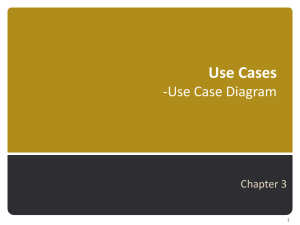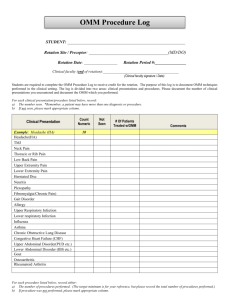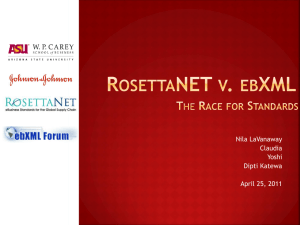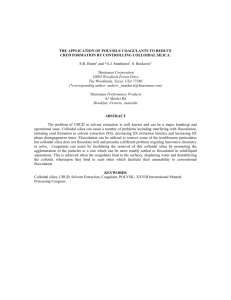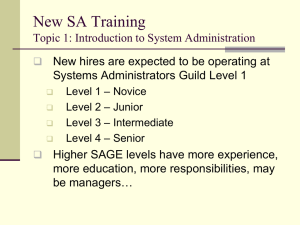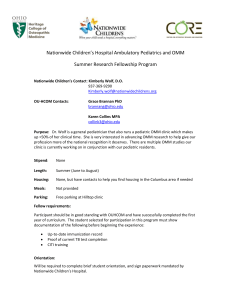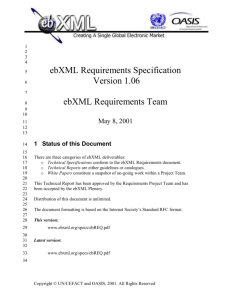Exploration on Open Media Marketplace
advertisement
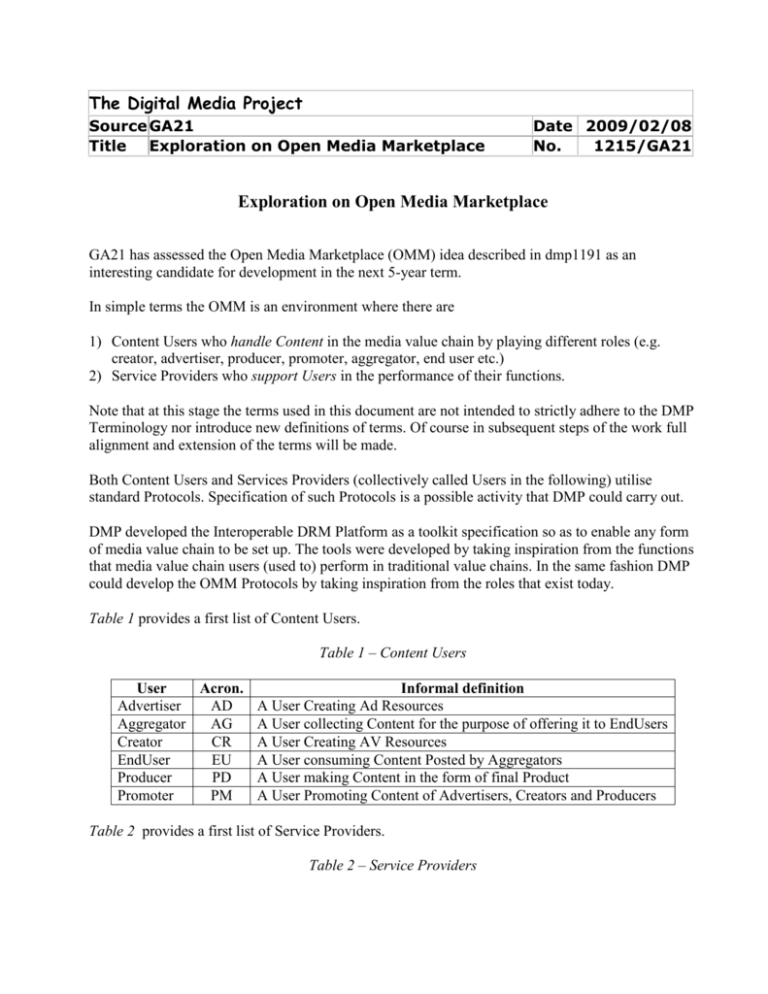
The Digital Media Project Source GA21 Title Exploration on Open Media Marketplace Date 2009/02/08 No. 1215/GA21 Exploration on Open Media Marketplace GA21 has assessed the Open Media Marketplace (OMM) idea described in dmp1191 as an interesting candidate for development in the next 5-year term. In simple terms the OMM is an environment where there are 1) Content Users who handle Content in the media value chain by playing different roles (e.g. creator, advertiser, producer, promoter, aggregator, end user etc.) 2) Service Providers who support Users in the performance of their functions. Note that at this stage the terms used in this document are not intended to strictly adhere to the DMP Terminology nor introduce new definitions of terms. Of course in subsequent steps of the work full alignment and extension of the terms will be made. Both Content Users and Services Providers (collectively called Users in the following) utilise standard Protocols. Specification of such Protocols is a possible activity that DMP could carry out. DMP developed the Interoperable DRM Platform as a toolkit specification so as to enable any form of media value chain to be set up. The tools were developed by taking inspiration from the functions that media value chain users (used to) perform in traditional value chains. In the same fashion DMP could develop the OMM Protocols by taking inspiration from the roles that exist today. Table 1 provides a first list of Content Users. Table 1 – Content Users User Acron. Informal definition Advertiser AD A User Creating Ad Resources Aggregator AG A User collecting Content for the purpose of offering it to EndUsers Creator CR A User Creating AV Resources EndUser EU A User consuming Content Posted by Aggregators Producer PD A User making Content in the form of final Product Promoter PM A User Promoting Content of Advertisers, Creators and Producers Table 2 provides a first list of Service Providers. Table 2 – Service Providers Service Provider Create Metadata Convert Unit Acron. CM CU Deliver Content Edit Resource Identify Content Identify User Post Content Record Exception DC ER IC IU PC RE Record Transaction Store Content RT SC Informal definition A SP who knows all content metadata, including licenses A SP who converts money into points and viceversa (e.g. as in dmin.it iPay) A network service provider A SP who offers audio-visual editing services A DMP Content Registration Agency A DMP User Registration Agency An ISP for a specific delivery technologies A SP who records point transactions not backed up by real money (e.g. in the dmin.it iPay system) A SP who records point transactions (e.g. as in the dmin.it iPay system) A SP who provides Content hosting services Error! Reference source not found.Figure 1 provides a graphical representation of Content Users and Service Providers active in the value chain considered for the model. Figure 1 – Graphical representation of a value chain Note that Green squares represent Content Users Light blue squares represent Service Providers A possible way to derive a list of all necessary Protocols is by carrying out the following sequence of steps 1. 2. 3. 4. Study all theoretically possible Nx(N-1)/2 interactions between the N Users identified List the interactions that are meaningful Describe the protocols that are needed to support the said meaningful interactions Remove all duplicate protocols and obtain the minimal list 5. Determine the technology to be used in Protocol specification 6. Specify all Protocols that have been identified in 4., possibly using protocols that already exist 7. Define and specify whatever other Protocol that may be needed to support the business of a User. In this way anybody can play a Role in the OMM by suitably combining Protocols (Note: Role is defined as the ability of a User or Service Provider to execute one or more than one specific Protocols). It is useful to make the following disclaimers 1. The OMM provides the means to map media value chains from the real to the OMM. This mapping is expected to open up new possibilities, not to lock the OMM into being a photocopy of the real world 2. In a given OMM instance there is no guarantee that a particular service provider which performs a useful role in a media value chain of the real world will continue to play a useful role in that OMM instance 3. In a given OMM instance Users may freely decide to play the Role that is convenient to implement their business model. It is to be noted that, in order to have a really open OMM it is also necessary to give prospective participants the ability to understand which Users already operate in a given media Value Chain. Electronic Business Extensible Markup Language (ebXML) seems to offer a possible solution1 as it claims to be “designed to create a global electronic market place where enterprises can find each other electronically and conduct business” Using exchange of XML messages According to standard business process sequences With clear business semantics Using off the shelf purchased business applications According to mutually agreed trading partner protocol agreements. Therefore the OMM should provide 1. A set of standard Protocols by the use of which a User can exchange information with any other User 2. The means to add new Protocols 3. The means for Users to configure a Role using any combination of standard Protocols 4. The means for Users to publish their Roles so that they can be discovered. Table 3 provides a first list of OMM Protocols derived by applying the method outlined above. Table 3 – First list of Protocols required by OMM 1 A brief introduction to ebXML is given in Error! Reference source not found. using material available at [1]. NB: CRUD stands for Create, Read, Update, Delete Protocol Authenticate User Authenticate Content Communicate Credit Communicate Debit Credit Unit CRUD Account CRUD Assets CRUD Campaign CRUD Group CRUD Licence CRUD Licence Template CRUD Metadata CRUD Metadata Template CRUD Playlist CRUD Site Debit Unit Deliver Content Edit Content Generate Event Negotiate Licence Post Content Query Content Query Playlist Query Site Query User Rate Content Rate Group Rate Playlist Rate Site Recommend Content Recommend Playlist Remunerate User Request Service Search Content Search Group Search Playlist Search Resource Notes US1 requests IU to Authenticate US2 US1 requests IC to Authenticate Content RT sends US1 notification that his Account has been Credited as a result of a Transaction made by U2 RT sends US1 notification that his Account has been Credited as a result of a Transaction made to U2 US requests CU to Credit Units to Account US requests RT to CRUD Account US requests SC to CRUD Assets US requests PM to CRUD Campaign US requests PC to CRUD Group US requests CM to CRUD a Licence US requests CM to CRUD a Licence Template US requests CM to CRUD Metadata US requests CM to CRUD Metadata Template US requests CP to CRUD Playlist US CRUDs Site US requests CU to Debit Units to Account US1 requests DC to Deliver Content to US2 US requests ER to Edit Resource US generates Content Event and sends it to CM US1 requests CM to assist in the development of Licence for US2 US requests PC to Post Content US Queries CM about Content US Queries CP about Playlist US Queries PC about Site US1 Queries RE about the Status of US2 US Rates a Content and sends Rating to CM US Rates a Group and sends Rating to PC US Rates a Playlist and sends Rating to CP US Rates a Site and sends Rating to PC US1 Recommends Content to US2 US1 Recommends Content to US2 US requests RT to Remunerate US2 US requests SP’s Service US1 Searches Content from US2 US requests PC to list User Groups satisfying a search criterion US requests PP to list Playlists satisfying a search criterion US requests CM to List Resources satisfying a search criterion Search Site Search User Select Content US requests PC to list Sites satisfying a search criterion US1 requests PC to list Sites satisfying a search criterion US Selects Content for Delivery For more details the reader is directed to dmp1191. Everybody is invited to bring contributions on the following aspects 1) 2) 3) 4) The nature and objectives of the project The proposed process to develop the project Relationships with Media Value Chain Ontology (MVCO) Suitability of ebXML for the identified purpose or identification of additional technologies References 1. 2. 3. 4. 5. 6. 7. http://www.tutorialspoint.com/ebxml/ebxml_introduction.htm http://www.tutorialspoint.com/ebxml/ebxml_architecture.htm http://www.tutorialspoint.com/ebxml/ebxml_business_process.htm http://www.tutorialspoint.com/ebxml/ebxml_registry_service.htm http://www.tutorialspoint.com/ebxml/ebxml_core_components.htm http://www.tutorialspoint.com/ebxml/ebxml_usage_example.htm http://www.freebxml.org/

